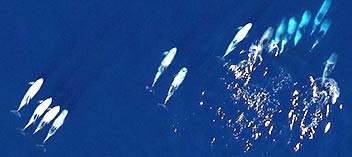Protecting the Dynamic Ocean
Understanding the environment to minimize conflicts
New York’s Offshore Wind Master Plan explores development in deep water and expanding our offshore wind workforce.
NYSERDA is helping to develop offshore wind to meet our energy needs while reducing environmental impacts from fossil fuels. As with all infrastructure, offshore wind energy development can impact the environment around it. However, it will also help reduce the long-term effects of climate change on New York’s marine ecosystems.
Our coastal areas support biodiverse marine ecosystems and significant economic activity, including fisheries and shipping, that employ thousands of New Yorkers. Managing a dynamic ocean means balancing environmental conservation and economic development. NYSERDA’s research and stakeholder engagement efforts are aimed at understanding potential risks to develop offshore wind energy in a responsible manner that minimizes impacts on the marine environment and economy.
New York’s Dynamic Ocean
Fish and Fisheries
More than 300 species of fish move between estuarine, inshore, and offshore habitats across the New York Bight. Some of the most common species found include lobster, butterfish, mackerel, herring, scallops, sea bass, sharks, rays, flounder, haddock, crab, and squid, among others.
With so many diverse species, New York is home to an active commercial, for-hire, and recreational fishing industry, and NYSERDA has been working to understand the sensitivities of fish populations, habitats, and fisheries to offshore wind energy development.
Marine Mammals and Sea Turtles
Marine mammals, including whales, dolphins, porpoises, and seals, are found throughout the New York Bight. Humpback, fin, and North Atlantic right whales typically feed in the Bight and are present year-round, with numbers varying seasonally. Sperm whales, dolphins, beaked whales, harbor porpoises, and harbor and gray seals also inhabit the New York Bight. Harbor porpoises and seals tend to move north of the Bight in summer, while pilot, sperm whales and other species migrate seasonally.
The most common sea turtle in the New York Bight is the loggerhead sea turtle, but studies have also found Kemp’s ridley, leatherback, and green sea turtles. Sea turtles migrate into the Bight during the summer and travel south of the Bight to warmer waters during the winter.
Birds
Birds in the New York Bight belong to seven broad groups—waterfowl (such as ducks, geese, and swans), loons, pelagic birds (birds that live in the open ocean for extended periods of time such as shearwaters and petrels), cormorants, shorebirds, alcids, and gulls and terns. While birds live in areas throughout the New York Bight, they are more common in shallower waters near the coast, an area called the Hudson Shelf Valley, and the continental shelf break.
Bird species use the New York Bight differently and at varying times of the year. Waterfowl generally use the shallower waters closer to the coast, while pelagic birds are found in deeper waters further from shore. Shallower waters are also usually home to higher numbers of birds during the winter, while deeper waters are home to more birds in the spring. There is less variability in the number of birds during the summer and fall. Migratory periods bring different species of birds to the region, but they tend to spend less time as they transit through.
Shipping and Navigation
In 2022, the Port of New York and New Jersey became the busiest port in the United States. The New York Bight vessel traffic is related to a range of commercial and recreational uses including cargo, fossil fuel tankers, tug and barge, cruise ships, law enforcement, commercial and recreational fishing, and sailing. Large vessels, like cargo ships, generally stay within designated traffic lanes, while smaller vessels are able to transit throughout the region.
Report: The Dynamic Ocean [PDF]
Learn More About Environmental Research and Data
-

NYSERDA Environmental Research
Read More NYSERDA Environmental ResearchExplore research related to New York’s marine environment and fisheries that’s informing the responsible and cost-effective development of offshore wind energy.
-

Engaging Ocean Experts
Read More Engaging Ocean ExpertsAccess materials from technical working groups, scientific studies, and researchers engaged with environmental and wildlife research related to offshore wind energy development.
